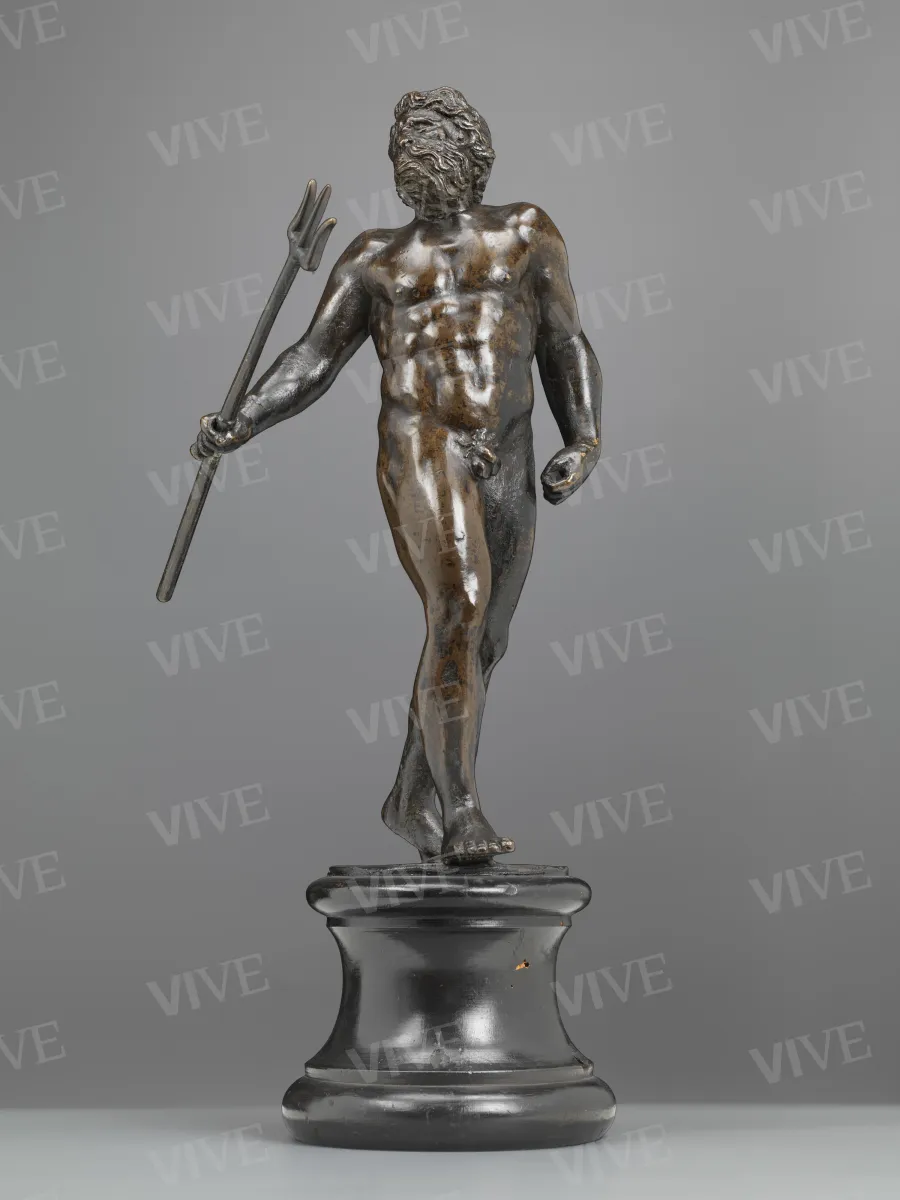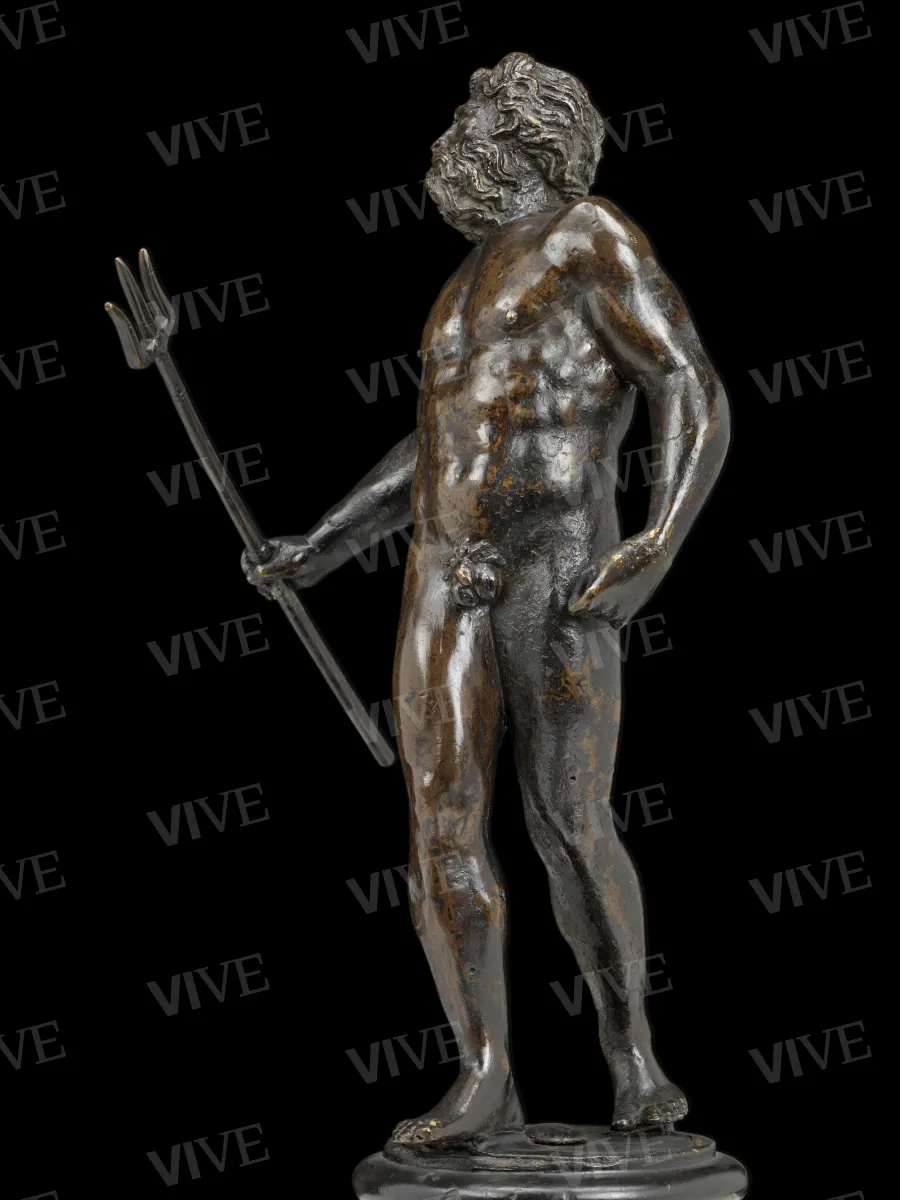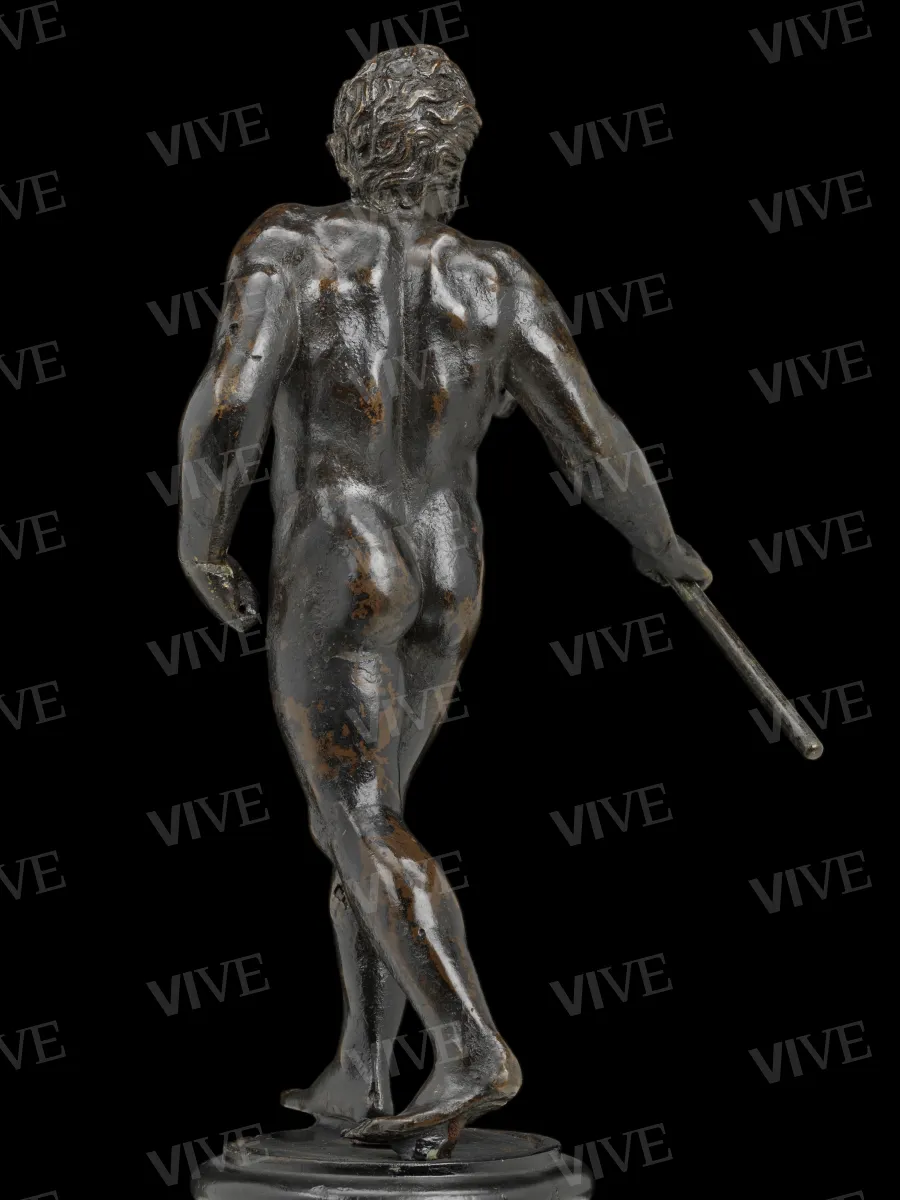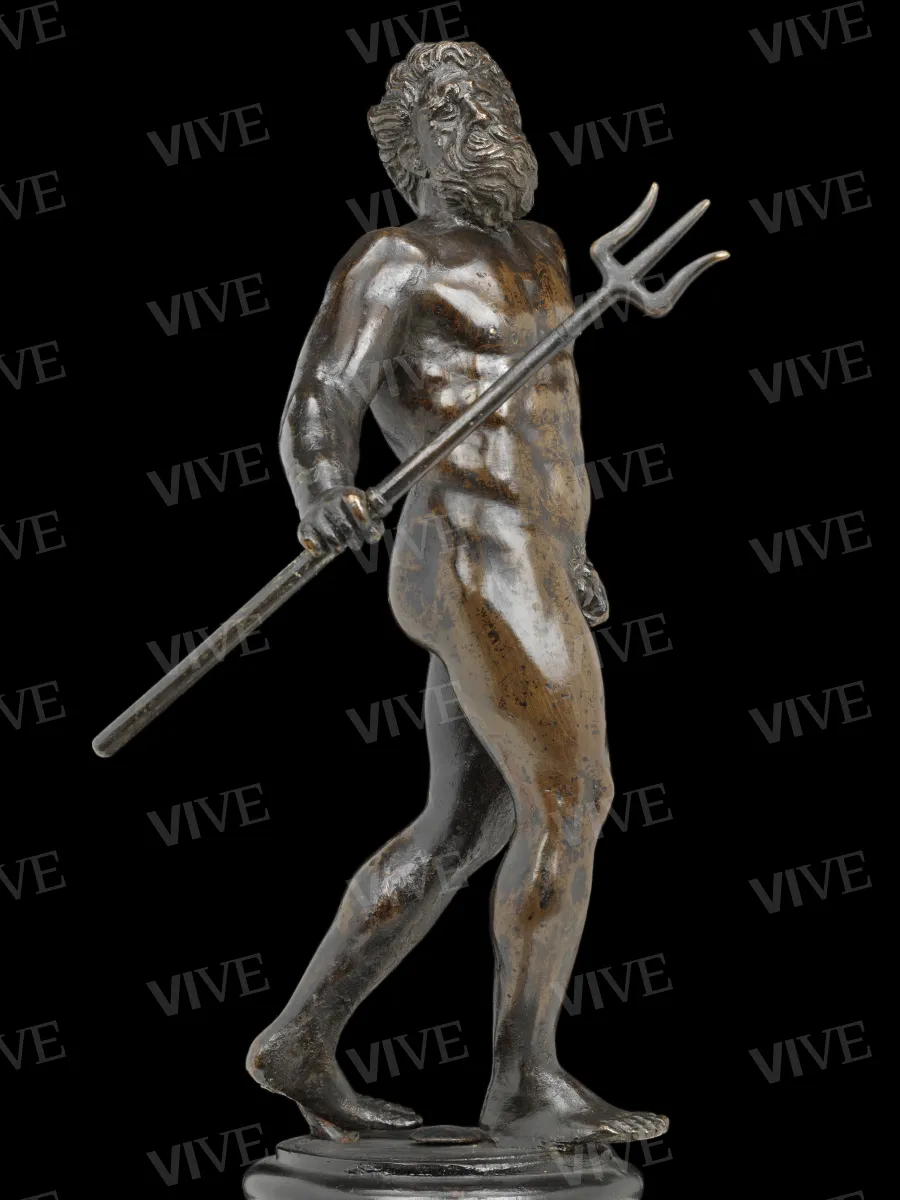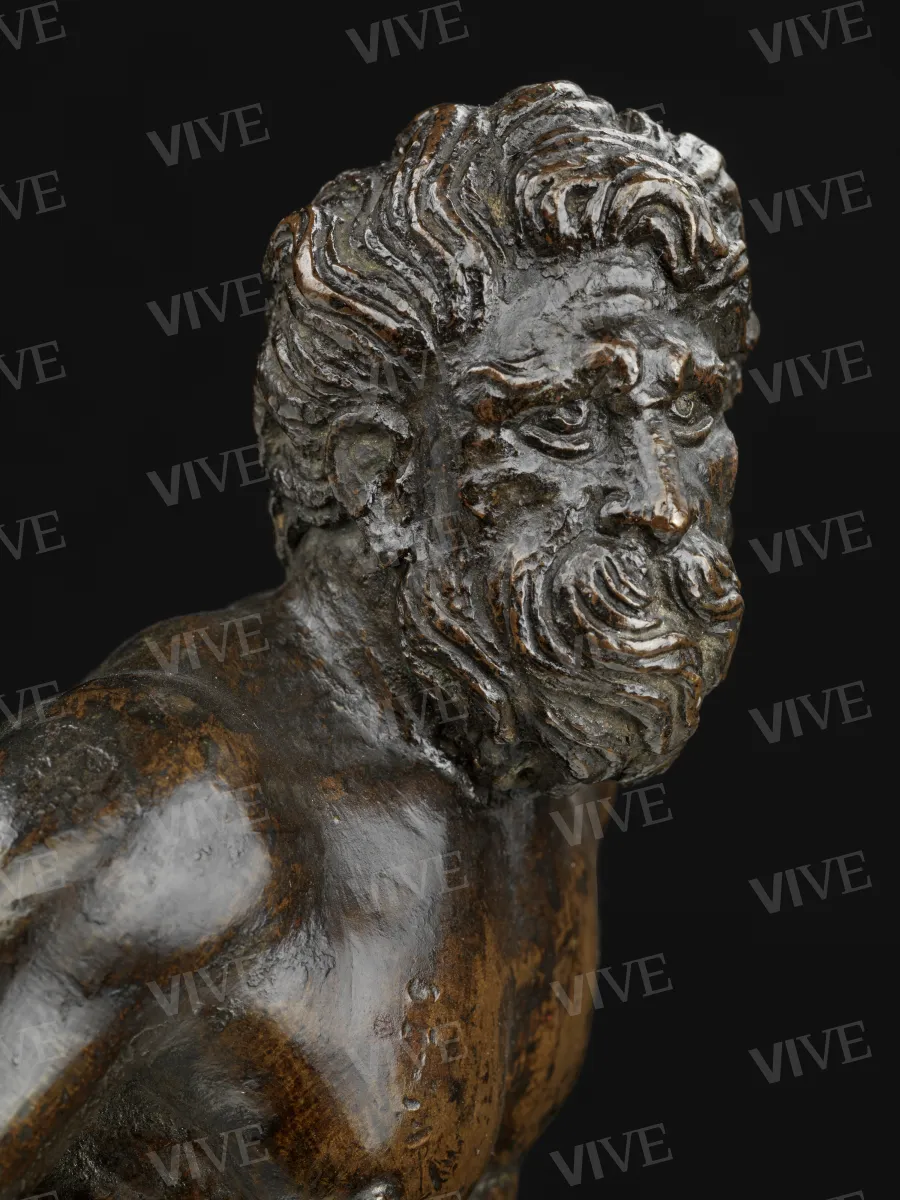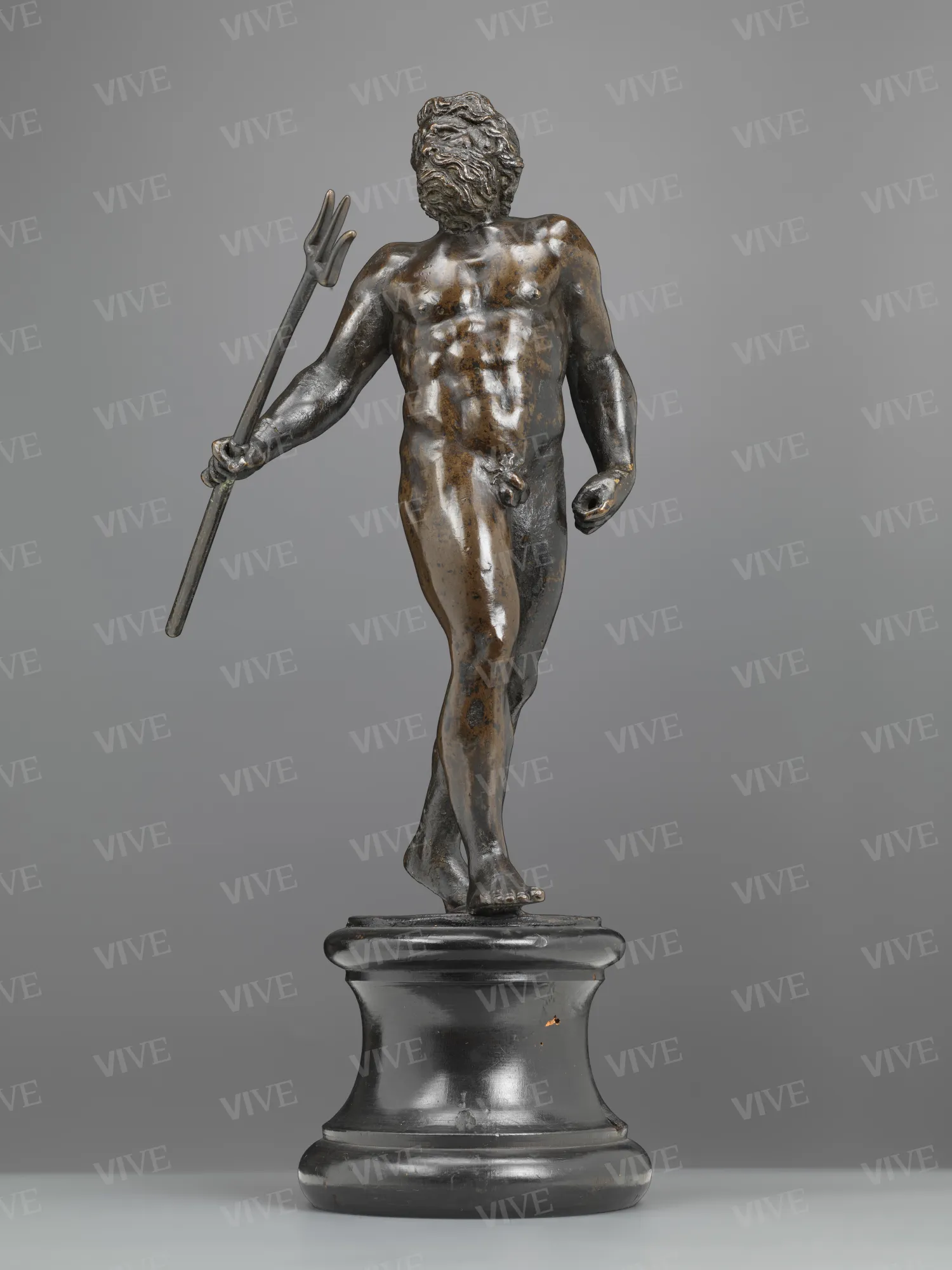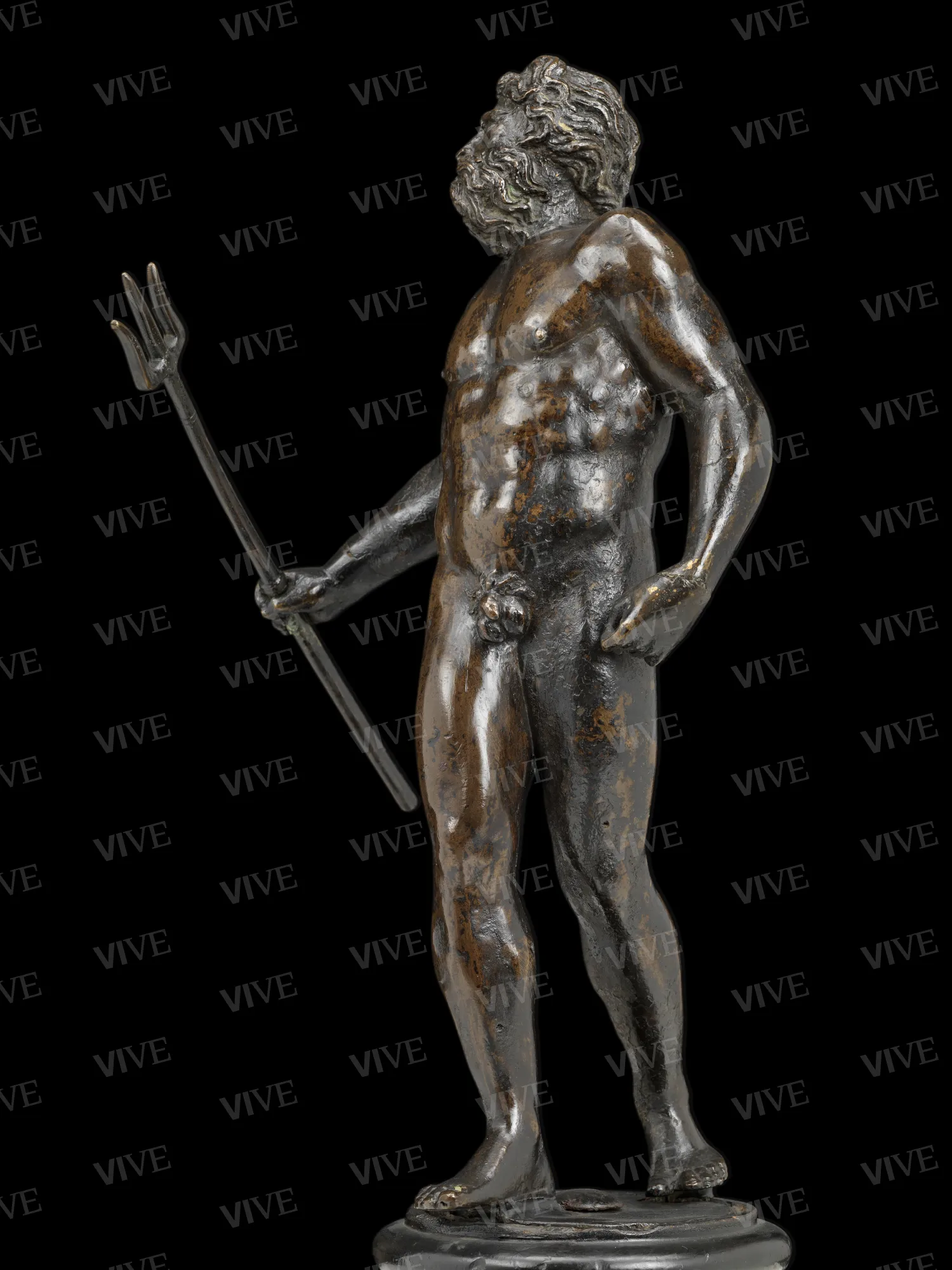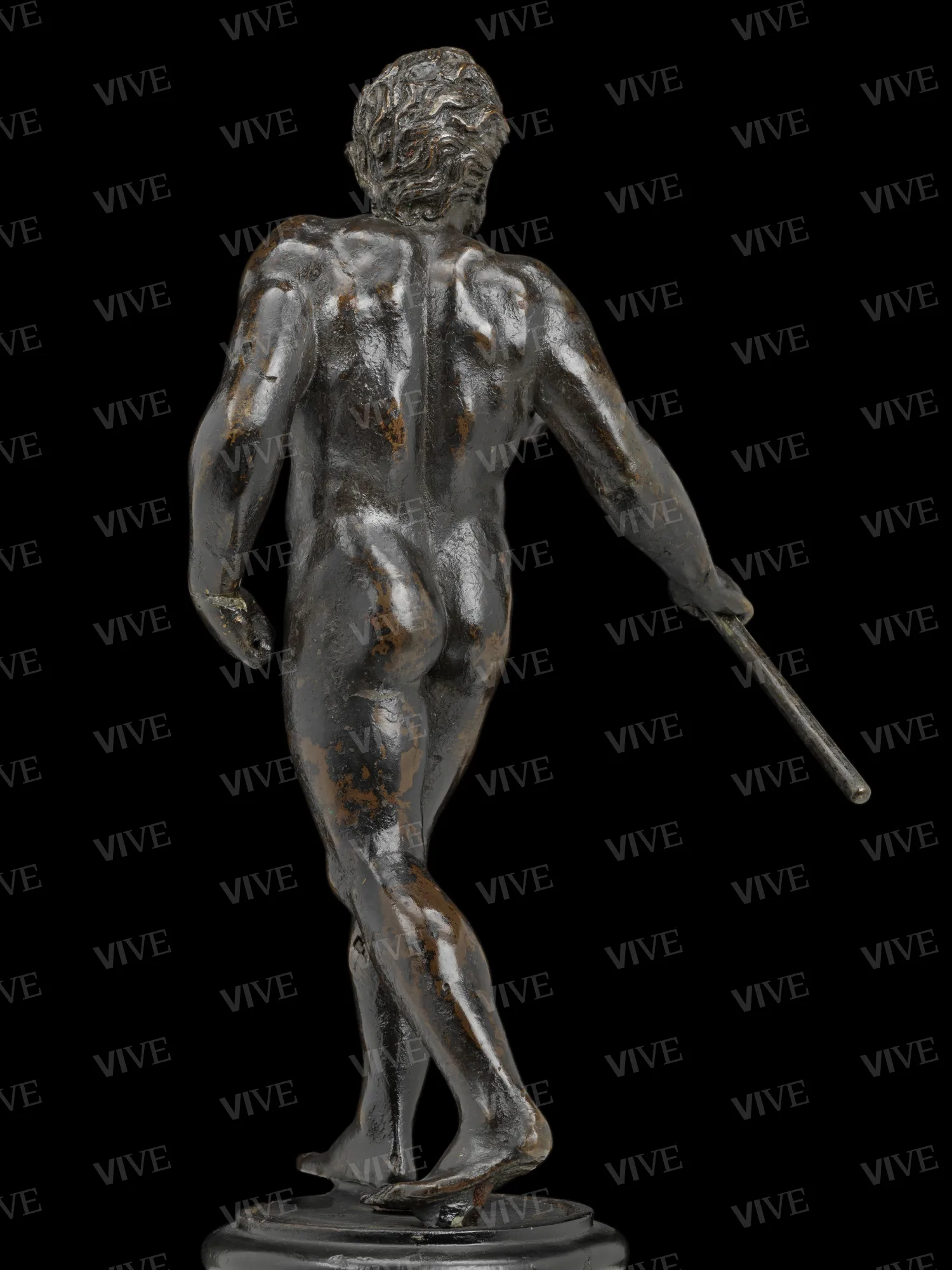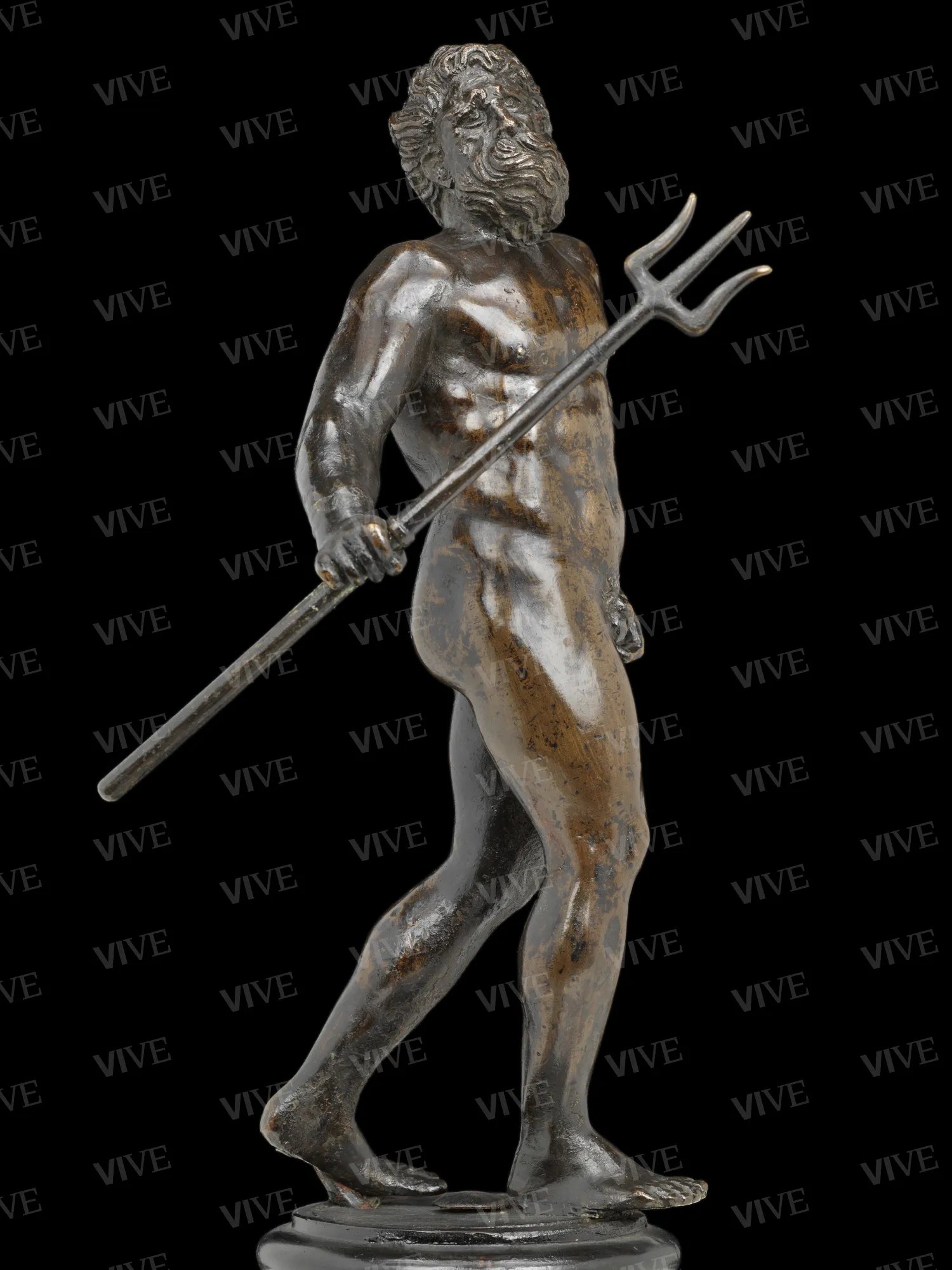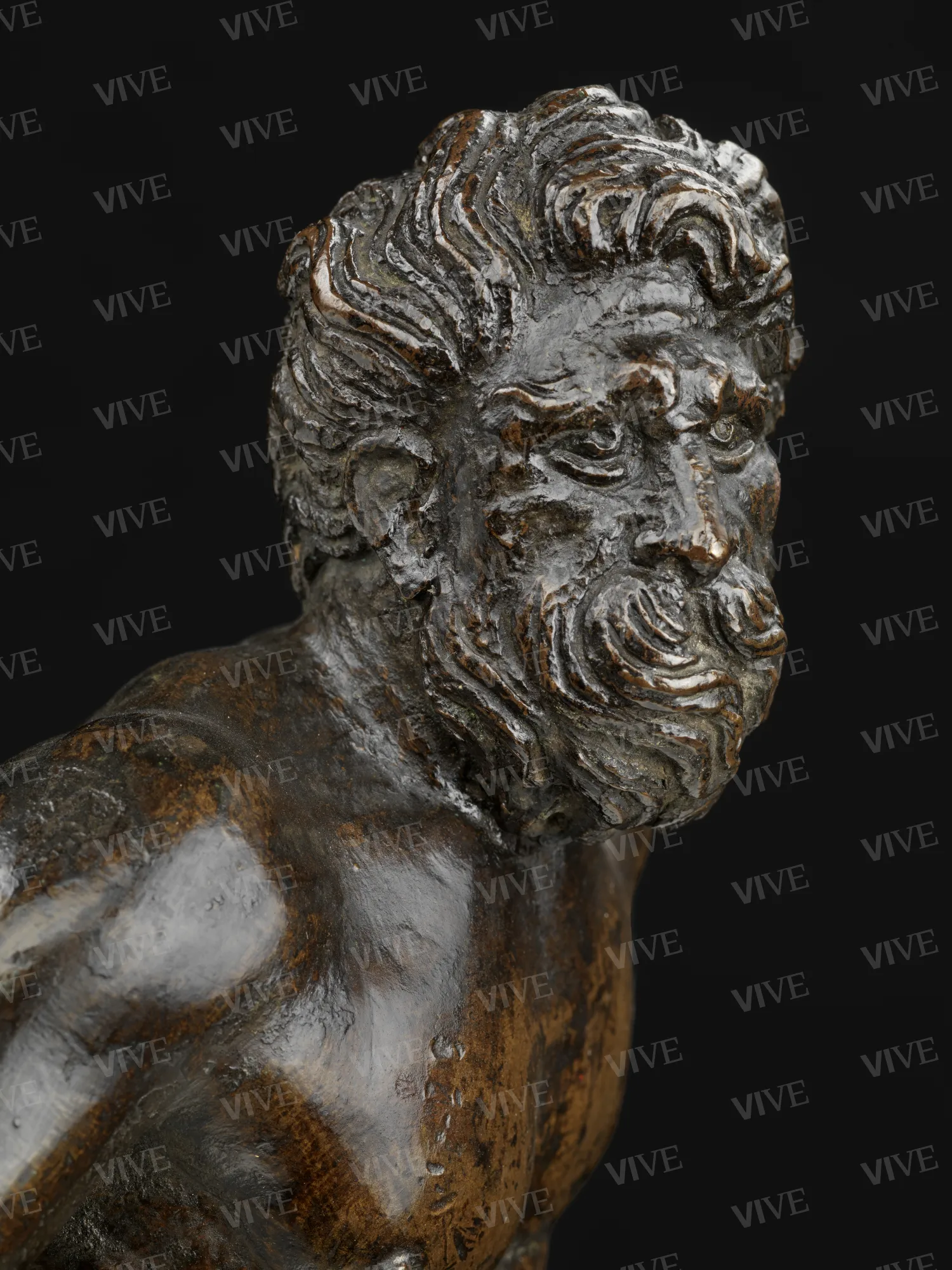Neptune (Quos Ego)
Tiziano Aspetti called Minio C. 1540–1545
The bronze statue of Neptune by Tiziano Aspetti, also known as Minio, depicts the sea god navigating through the sea while grasping his trident and holding the reins of the sea horses that pull his chariot. This representation includes elements commonly seen in other works. The artist captures a specific moment from Virgil’s "Quos Ego," where Neptune pacifies the storm threatening the Trojans’ ships.
The bronze statue of Neptune by Tiziano Aspetti, also known as Minio, depicts the sea god navigating through the sea while grasping his trident and holding the reins of the sea horses that pull his chariot. This representation includes elements commonly seen in other works. The artist captures a specific moment from Virgil’s "Quos Ego," where Neptune pacifies the storm threatening the Trojans’ ships.
Details of work
Catalog entry
The small bronze sculpture from the Collezione Auriti (Santangelo 1964) portrays Neptune, the god of the sea, navigating the waters. The figure’s body appears disjointed and tense: he holds a trident (a later addition) in one hand and is turned to the left, his hair and beard blowing in the wind. The other hand, now empty, originally held the reins of a chariot pulled by sea horses, on which the god was standing (the chariot is present in other examples).
Critics have noted that the artist illustrates the episode from Virgil’s “Quos Ego,” when Neptune calms the storm threatening the Trojan ships (Virgil, Aeneid, I, 124–156). Antonino Santangelo brought attention to the bronze statue in Palazzo Venezia in 1964. However, other examples had already been studied by critics since the early twentieth century, particularly through the pioneering work of von Bode and Planiscig. Von Bode (1904) attributed the statue to Jacopo Sansovino, while Planiscig (1921) suggested it was by Tiziano Aspetti, also known as Minio (c. 1511/1512–1552), a Paduan sculptor and collaborator of Sansovino. Planiscig noticed similarities between the statue’s structure and the figures on the Loggetta in Saint Mark’s Square. Later, Planiscig revised his opinion and attributed the sculpture to Sansovino (Planiscig 1924; Planiscig 1930; Planiscig, Kris 1935). While most scholars accepted the attribution to Minio, there were dissenting opinions, such as John Pope-Hennessy (1963; 1968, workshop of Sansovino) and Draper (von Bode, rev. Draper 1980, 102 n. CLVII, northern Italian). Subsequent scholars generally supported the attribution to Minio (Montagu 1965; Weihrauch 1967, 141; Leithe-Jasper 1973; Wixom 1975; Leithe-Jasper 1976; Leithe-Jasper 1986; Leithe-Jasper 1999; Leithe-Jasper 2001; Richard, in Katz 2007, 28–31).
The work is documented through various examples considered to be autographs, including those from Rome (Vienna, Kunsthistorisches Museum, inv. 5748 and 5911; Blessington, Alfred Beit Foundation, inv. 260; Braunschweig, Anton Ulrich-Museum, inv. Bro 108; Cleveland, The Cleveland Museum of Art, inv. 74.273) or from Minio’s circle (Turin, Palazzo Madama, inv. 165/B) or lower quality derivations (London, Victoria & Albert Museum, inv. A.80-1949; Vienna, Kunsthistorisches Museum, inv. 5635; Toulouse, Fondation Bemberg Musée). Among these, six consist of both Neptune and the chariot (Blessington, Braunschweig, Cleveland, Toulouse, Turin, Vienna), three of the deity alone (London, Rome, Vienna). The bronze Sir George Leon’s collection, which has been modified into a table fountain, is yet to be traced. There are later versions of the bronze produced in the workshops of Pankraz Labenwolf and Benedikt Wurzelbauer in Nuremberg, indicating its particular popularity in Germany (Weihrauch 1967, 317–318, 329–331, figs. 401–402).
The example in Palazzo Venezia has undergone modifications, likely in the nineteenth or early twentieth century. These alterations include the circular metal base, the wooden pedestal, and the trident. Notably, only the examples in Turin and London retain a portion of the original trident. The work exhibits signs of trauma, evidenced by the loss of the trident and the breakage and subsequent repair of both hands. Regarding Neptune's composition, Minio could have drawn inspiration from existing artistic versions of Quos ego: Raphael’s graphic studies, later engraved by Marcantonio Raimondi (Nees 1978; Gnann 1999, pp. 114–115, cat. nos. 53–54), and Perino del Vaga’s oil painting in the Shipwreck Room at the Villa del Principe in Genoa (Gnann 2001, pp. 208–210, cat. nos. 99–100). However, Minio’s composition appears to reflect the figures conceived by his mentor Sansovino. Specifically, one of the small reliefs on the Loggetta depicts Quos ego, showing the deity from behind on a chariot pulled by two sea horses. The god holds the reins in his left hand and raises his trident with his right (Pietrobelli 2018–2022). The stone composition bears significant resemblance to the bronze version, not only in terms of attributes and the elevated pose of the bust but also in the muscular form of the deity. It is plausible that Minio was influenced by models and sketches available in Sansovino’s workshop. Initially, the bronze was dated to the early 1540s (Wixom 1975, cat. no. 114), later revised to circa 1545 (Leithe-Jasper 1999; Leithe-Jasper 2001; Cannata 2009; Cara 2016) or to the late 1550s (Cannata 2011). Considering the stylistic and compositional similarities with the figures in the Loggetta, a more accurate dating would be within the period 1540-1545, closely aligned with the bronze statue of Saturn in the Kunsthistorisches Museum in Vienna (inv. 5663; Pietrobelli 2023).
Giulio Pietrobelli
Entry published on 12 June 2025
State of conservation
Good. The item features glossy black paint on natural brown patina. The trident is not authentic, and the hands have been reattached.
Restorations and analyses
The work was restored, likely during the nineteenth or early twentieth century, following a significant incident. The restoration included repairing the broken hands and replacing the missing trident.
Provenance
Vienna, Collezione Giacinto Auriti, formed between 1922 and 1933;
Rome, Museo Nazionale di Palazzo Venezia, donated in 1963.
References
von Bode Wilhelm, The Art Collection of Mr. Alfred Beit at His Residence 26 Park Lane London, Berlin 1904, pp. 40, 64;
Planiscig Leo, Venezianische Bildhauer der Renaissance, Wien 1921, p. 405;
Planiscig Leo, Kunsthistorisches Museum Wien. Die Bronzeplastiken, Statuetten, Reliefs, Geräte und Plaketten, Wien 1924, pp. 86-87, 90, nn. 153-154;
Planiscig Leo, Piccoli bronzi italiani del Rinascimento, Milano 1930, p. 32, tav. CXLIV, fig. 252;
Planiscig Leo, Ernst Kris, Katalog der Sammlungen für Plastik und Kustgewerbe, Wien 1935, p. 61, n. 15;
Pope-Hennessy John, Italian Bronze Statuettes-II, in «The Burlington Magazine», 105, 1963, 719, pp. 58-71;
Santangelo Antonino, Museo di Palazzo Venezia. La Collezione Auriti. Piccoli bronzi, placchette, incisioni e oggetti d’uso, Roma 1964, pp. 17-18, tav. XII;
Montagu Jennifer, Les bronzes, Paris 1965, pp. 4, 29 fig. 21 (scuola di Sansovino), pp. 44, 46 (T. Minio);
Weihrauch Hans, Europäische Bronzestatuetten. 15.-18. Jahrhundert. Braunschweig 1967, pp. 141, 329-330, fig. 400;
Pope-Hennessy John, Essays on Italian Sculpture, London 1968, pp. 184, 226;
Leithe-Jasper, in Italienische Kleinbronzen und Handzeichnungen der Reniassance und des Manierismus aus Österreichischem Staatsbesitz, Itaria Runessansu no buronzuto sobyo, catalogo della mostra (Tokyo, Nationalmuseum für Westliche Kunst, Kokuritsu Seiyo Bijutsukan, 18 agosto-14 ottobre 1973), Tokyo 1973, n. 43;
Wixom William, Renaissance Bronzes from Ohio Collections, Cleveland 1975, n. 114;
Leithe-Jasper, in Italienische Kleineplastiken, Zeichnungen und Musik der Renaissance Waffen des 16. und 17. Jahrhunderts, catalogo della mostra (Vienna, Schloss Schallaburg, 1 maggio-2 novembre 1976), Wien 1976, pp. 91-92, n. 95;
Nees Lawrence, Le Quos ego de Marc-Antoine Raimondi. L’Adaptation d’une source antique par Raphael, in «Nouvelles de l’estampe», 40-41, 1978, pp. 18-29;
von Bode Wilhelm, The Italian Bronze Statuettes of the Renaissance, new edition edited and revised by James David Draper, New York 1980, p. 102, fig. CLVII;
Leithe-Jasper, in Leithe-Jasper Manfred (a cura di), Renaissance Master Bronzes from the Collection of the Kunsthistorisches Museum Vienna, catalogo della mostra (Washington DC, National Gallery of Art; Los Angeles, Los Angeles County Museum of Art; Chicago, The Art Institut of Chicago, 1986), London 1986, pp. 171-174;
Gnann, in Oberhuber Konrad (a cura di), Roma e lo stile classico di Raffaello 1515-1527, catalogo della mostra (Mantova, Palazzo Te, 20 marzo-30 maggio 1999; Vienna, Graphische Sammlung Albertina, 23 giugno-5 settembre 1999), Milano 1999, pp. 114-115, catt. 53-54;
Leithe-Jasper, in Bacchi Andrea, Camerlengo Lia, Leithe-Jasper Manfred (a cura di), “La bellissima maniera”. Alessandro Vittoria e la scultura veneta del Cinquecento, catalogo della mostra (Trento, Castello del Buonconsiglio, 25 giugno-26 settembre 1999), Trento 1999, pp. 228-229, n. 15;
Leithe-Jasper, in Banzato Davide (a cura di), Donatello e il suo tempo. Il bronzetto a Padova nel Quattrocento e nel Cinquecento, catalogo della mostra (Padova, Musei Civici, 8 aprile 2001-15 luglio 2001), pp. 244-245, n. 66;
Gnann, in Parma Elena (a cura di), Perino del Vaga tra Raffaello e Michelangelo, catalogo della mostra (Mantova, Palazzo Te, 18 marzo-10 giugno 2001), Milano 2001, pp. 208-210, catt. 99-100;
Richard, in Master Bronzes from the Beit Collection, (London, Daniel Katz Gallery, 30 May-13 July 2007), London 2007, pp. 28-31;
Cannata, in Barberini Maria Giulia, Sconci Maria Selene (a cura di), in Guida al Museo Nazionale del Palazzo di Venezia, Roma 2009, p. 72,, n. 71;
Cannata, in Cannata Pietro, Museo Nazionale di Palazzo di Venezia. Sculture in bronzo, Roma 2011, pp. 106-108, cat. 120;
Cara, in Bava Anna Maria, Pagella Enrica (a cura di), Le meraviglie del mondo. Le collezioni di Carlo Emanuele I di Savoia, catalogo della mostra (Torino, Galleria sabauda, 16 dicembre 2016-2 aprile 2017), Genova 2016, p. 223, cat. 114 e p. 247;
Pietrobelli Giulio, Tiziano Minio “homo ingeniosus, caelator eximius, sculptorque & fusor celeberrimus“, tesi di Dottorato in storia, critica e conservazione dei beni culturali, Università degli studi di Padova, Dipartimento dei beni culturali, tutor prof.ssa Alessandra Pattanaro, a.a. 2018-2022, pp. 206, 287 n. 22, 434, fig. 402;
Pietrobelli Giulio, In margine al collezionismo. Tiziano Minio e la circolazione di modelli nella Padova di Bembo, in Cassia Cristina (a cura di), Musica e cultura nella Padova di Bembo, Lucca 2023, 125-111.

